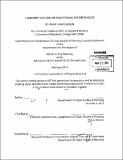Community building in transitioning neighborhoods
Author(s)
Larios Berlin, Jenny
DownloadFull printable version (26.40Mb)
Other Contributors
Massachusetts Institute of Technology. Department of Urban Studies and Planning.
Advisor
Lawrence Vale.
Terms of use
Metadata
Show full item recordAbstract
As of 2011, the population of the United States had become roughly 83% urban, but by the year 2050, 90% of the country will be living in urban areas. The residents that are already in these places, as well as those coming into the city, will have to adjust to each other in profound ways that challenge their previously held relationship with space and notions of community identity. The thesis develops the Diffuse Mosaic City model to explain the hypothesis that neighborhoods are composed of public spaces that are either intra-community zones that support the reinforcement of a single community group, or inter-community zones that, with the proper programming, can create opportunities for cross-community building. In the 1960s, Puerto Rican immigrants founded Villa Victoria as an ethnic enclave in Boston's South End district. However, it is undergoing a demographic shift, and by 2013, more than 40% of the population is not Puerto Rican with influxes of Chinese and African American populations. The older Puerto Rican community is concerned about the erosion of their history, which has created tensions among residents. Classical sociological theory deems this an invasion-succession scenario, where the incoming group will replace the pre-existing group, or a compromise will be reached that halts an entire population shift. The Diffuse Mosaic City model offers an improved way to address whether open public spaces can play a role in maintaining the history of Villa Victoria while embracing new incoming groups, and how the physical space can support social capital development for community cohesion in a transitioning neighborhood. The Diffuse Mosaic City model uses spatial analysis and workshops to investigate how community zones might foster inter-group cohesion. Based on my detailed on-site inventory of the public spaces, I hosted workshops to solicit feedback from a representative sample of Villa Victoria residents. The workshops invited 18 tenants (Puerto Ricans, African Americans, and Chinese Americans) to respond to clearly defined questionnaires, while I used cooperative techniques to elicit their cognitive maps of the use and perception of the open spaces by the various demographics. The results led to the conclusion that within Villa Victoria the ethnic group that shared its intra-community zone with the core of the development is the prominent group in the area. Finally, this thesis presents the Diffuse Mosaic Model's recommendations for how to best utilize the community's open spaces to preserve the area's history, while embracing natural population changes.
Description
Thesis: M.C.P., Massachusetts Institute of Technology, Department of Urban Studies and Planning, 2014. Page 145 blank. Cataloged from PDF version of thesis. Includes bibliographical references (pages 139-144).
Date issued
2014Department
Massachusetts Institute of Technology. Department of Urban Studies and PlanningPublisher
Massachusetts Institute of Technology
Keywords
Urban Studies and Planning.